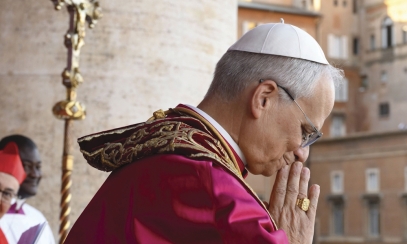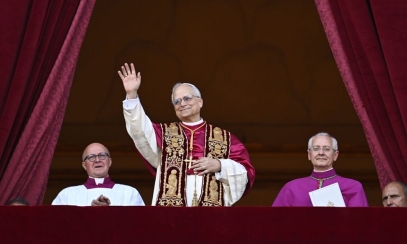The Papacy: Beliefs through the Ages
The pope (from the word for “father” in Greek) is the bishop of Rome and the visible and earthly leader of the Catholic Church. He is a vicar of Christ, the true head of the Church. He is the successor of St. Peter, an apostle and first pope. The papacy itself, as one of the most enduring institutions in the world, has played a major role in human history.
The pope (from the word for “father” in Greek) is the bishop of Rome and the visible and earthly leader of the Catholic Church. He is a vicar of Christ, the true head of the Church. He is the successor of St. Peter, an apostle and first pope. The papacy itself, as one of the most enduring institutions in the world, has played a major role in human history.
The Rock
One cannot understand Catholic belief about the papacy without understanding apostolic authority. Jesus established a living authority to teach, govern and sanctify his name called “Apostolic.” It began with the Twelve Apostles and continues through their successors.
The papacy itself emerges from Scripture where St. Peter is clearly identified as the head of the Apostles. One need look no further than Matthew 16:18-19 to find evidence of this and also that it was Jesus who established the role, its authority and its power:
And so I say to you, you are Peter and upon this rock I will build my Church, and the gates of the netherworld shall not prevail against it. I will give you the keys to the kingdom of heaven. Whatever you bind on earth shall be bound in heaven; and whatever you loose on earth shall be loosed in heaven.
Further, in John 21:15-17, Jesus makes it clear that Peter also will be the shepherd of his Church. If this wasn’t enough, Acts 15 demonstrates the early Church acknowledged the final authority of Peter in its account of the Council of Jerusalem as his statements are described as settling the doctrinal dispute in question.
The Early Church
The bishop of Rome was considered the head of the Church from the very beginning. For example, the fourth bishop of Rome, Pope Clement I, was summoned to settle a leadership matter in the Church at Corinth around 80 A.D. when appeal could have been made to St. John the Apostle, who was still living and closer to Corinth.
St. Irenaeus (130-202), who was taught by St. Polycarp – a disciple of St. John the Apostle – emphasized as a given that communion with the Church of Rome was essential in order to maintain the apostolic tradition. He then went on to list all popes to date. A further acknowledgment of the pope’s status came from an unlikely source: Roman emperors. In the first 200 years of the Church, every pope but one was martyred in persecutions by Roman emperors bent on the Church’s destruction. These emperors reasoned that striking the head of the Church would lead to its death. Despite these persecutions, the popes, as the recognized head of the early Church, did much to encourage the spread of Christianity and to resolve various doctrinal disputes.
The Middle Ages
The role of the pope grew in importance after the fall of Rome. He became a source of authority and of continuity in the secular world. In 800, Pope Leo III’s crowning of Charlemagne established that no one in the West would be emperor without anointing by a pope. Yet, when reforms became necessary due to corruption flowing from such secular power, it was Pope Gregory VII in 1073 who instituted them. Popes also called for the Crusades in response to the Muslim invasions of the Byzantine Empire and to regain Christian territories, especially Jerusalem.
Throughout the Middle Ages up until the Reformation in 1517, the authority of the pope was challenged by monarchs and anti-popes. The popes also had to contend with the cardinals who occasionally tried to put forth the notion that the Church councils had authority over the pope.
The Reformation and Beyond
As the Protestant Reformation gained steam, the papacy was criticized for its corruption. In response, popes called for a Catholic Counter-Reformation (1560-1648) to address the Protestant challenges and to institute internal reforms. The Council of Trent (1545-1563) gave the papacy a victory over those in the Church wanting conciliation with Protestants and who opposed papal claims through its definitions of doctrine and reforms.
However, popes gradually have been forced to give up temporal power and their authority almost exclusively is restricted to matters of faith. The dogma of papal infallibility in 1870 represents an assertion of this authority. The First Vatican Council declared when the pope speaks ex cathedra (“from the chair”) while issuing a solemn definition of faith or morals he was infallible. The only time this dogma has been put into practice was in 1950 when the pope defined the Assumption of Mary as a dogma.
It was the First Vatican Council that dogmatically defined the status and authority of the pope in its Dogmatic Constitution of the Church of Christ. It decreed that Peter was established by the Lord Christ as the chief of all the apostles, and the visible head of the whole Church with primacy in jurisdiction; that the papacy was instituted by Christ; and that Peter has perpetual successors in the person of the Roman pontiff.
The Second Vatican Council in its “Dogmatic Constitution on the Church” (1964) followed with the declaration that “In matters of faith and morals, the bishops speak in the name of Christ and the faithful are to accept their teaching and adhere to it with a religious assent. This religious submission of mind and will must be shown in a special way to the authentic magisterium of the Roman pontiff, even when he is not speaking ex cathedra; that is, it must be shown so that his supreme magisterium is acknowledged with reverence, the judgments made by him are sincerely adhered to, according to his manifest mind and will. His mind and will in the matter may be known either from the character of the documents, from his frequent repetition of the same doctrine, or from his manner of speaking.”
The role of the pope since the establishment of Vatican City in 1929 has expanded into the areas of international diplomacy, ecumenism, interreligious dialogue, works of charity and the defense of human rights. For example, after World War II, Pope Pius XII focused on material aid to the 15 million displaced persons and refugees and on the development of the Church’s worldwide diplomatic relations. He also internationalized the internal Church by moves such as appointing cardinals from Asia, South America and Australia.
Pope Paul VI became the first pope to visit all five continents and continued to work for the internationalizing of the Church by opening the Roman Curia to the bishops of the world rather than only cardinals.
The election of Pope John Paul II marked the first time in 455 years a non-Italian had ascended to the throne. He played a major role in the demise of communism in Eastern Europe by sparking a peaceful revolution in his homeland of Poland.
Pope Benedict XVI followed the long pontificate of Pope John Paul II and focused his efforts on combating secularization and relativism, especially in the West, until his retirement (the first voluntary resignation since 1294) on Feb. 28, 2013.
Pope Francis was the first pope of the Americas and the first Jesuit pope. He is remembered for his focus on social justice and compassionate leadership. He addressed issues facing the world and the Church today through his writings and reforms within the Vatican.
There can be no question that the pope is viewed as an international moral authority. As the spiritual leader of 1.2 billion Catholics worldwide in an age of instant information, extensive travel, command of multiple languages, diplomatic acumen, and personal holiness seem to have become standard prerequisites for the role.
The papacy: Last 100 years
Pope Benedict XV
Elected: 9-3-1914
Given name: Giacomo Paolo Giovanni Battista della Chiesa
He is known for his intervention to bring peace during World War I and for issuing the first ever Code of Canon Law. He reigned for seven years and 141 days. He died on Jan. 22, 1922, at age 67.
Pope Pius XI
Elected: 2-6-1922
Given name: Achille Ambrogio Damiano Ratti
He is best known for signing the Lateran Treaty, which established the Vatican City as a sovereign state. He also penned the encyclical Quadragesimo Anno commemorating the 40th anniversary of Leo XIII’s famous encyclical Rerum Novarum. He served 17 years, four days until his death on Feb. 10, 1939. He was 81.
Pope Pius XII
Elected: 3-2-1939
Given name: Eugenio Maria Giuseppe Giovanni Pacelli
Pius XII had served 19 years, 221 days, as pope when he died on Oct. 9, 1958 at age 82. While controversy about his role in World War II still swirls, he also is remembered for invoking papal infallibility, in 1950, as it regards the dogma of the Assumption of Mary. In 2009, Pope Benedict XVI declared him Venerable.
Pope John XXIII
Elected: 10-28-1958
Given name: Angelo Giuseppe Roncalli
Known as “Good Pope John,” this beloved pontiff reigned only four years, 218 days. During this time, he opened the Second Vatican Council, though he would not see it to its conclusion. He died on June 3, 1963, at age 81. He was declared Blessed by Pope John Paul II in 2000 and canonized by Pope Francis in 2014.
Pope Paul VI
Elected: 6-21-1963
Given name: Giovanni Battista Enrico Antonio Maria Montini
He was the first pope to travel to the United States and he brought the Second Vatican Council to a close. He reigned for 15 years, 46 days, until his death on Aug. 6, 1978. He was 80. He was declared Venerable in 2012 by Pope Benedict XVI and canonized by Pope Francis in 2018.
Pope John Paul I
Elected: 8-26-1978
Given name: Albino Luciani
He had reigned for only 33 days when he died on Sept. 28, 1978, at age 65. Known as “The Smiling Pope,” he was the first pope to use two names (taken from his two immediate predecessors.) He was beatified by Pope Francis in 2022.
Pope John Paul II
Elected: 10-16-1978
Given name: Karol Józef Wojtyla
He was the first Polish pope and the first non-Italian pope in 455 years. He reigned for 26 years, 168 days, until his death on April 2, 2005, at the age of 84. Beatified in 2011 by Pope Benedict XVI and canonized by Pope Francis in 2014, John Paul II is considered one of the most influential leaders of the 20th century.
Pope Benedict XVI
Elected: 4-19-2005
Given name: Joseph Aloisius Ratzinger
At 78, he became the oldest person elected pope since Clement XII in 1730. He advocated a return to Christian values as the way to counter an ever-increasing secularization of the world, especially in the West, until his retirement on Feb. 28, 2013, at age 85. He reigned for seven years, 315 days, until he became the first pope to renounce the papacy since 1415, and the first to do so on his own initiative since 1294.
Pope Francis
Elected: 3-13-2013
Given name: Jorge Mario Bergoglio
He was elected pontiff at the age of 76 and his papacy lasted 12 years. Francis was known for his simplicity, his concern for the poor and marginalized and encouraging Church leaders to listen to the faithful rather than simply issuing edicts. He also instituted significant reforms to Vatican finances.
The Conclave
What is a conclave? From a Latin word meaning “with key,” it normally takes place 15-20 days after the pope’s death. The College of Cardinals sets the exact date. By law, the conclave begins in the Sistine Chapel. The cardinals celebrate the Votive Mass and begin the election process.
Who participates? Cardinals younger than 80 have the right to vote for the next pope. They are attended by cooks, housekeepers and medical personnel. Everyone involved must swear an oath of secrecy.
What happens? The cardinals are locked in to prevent any outside influence on their voting. Election takes place by secret ballot. Blank ballots are prepared and distributed. The electors write the name of the candidate on the lower half and fold it in two.
- Each of the active cardinals walks to an altar in order of seniority and pledges to perform his duty with integrity.
- Each cardinal then places a folded ballot containing his choice onto a small disc made of precious metal and drops it inside a chalice.
- The ballots are read by three scrutineers, or tellers, who are selected by lot. As the names on the ballots are called out, one of the scrutineers threads the ballots together. If a cardinal receives two-thirds of the votes, he is the new pontiff.
- If there is no winner, another vote is taken.
What is the smoke? The threaded ballots are burned, with chemicals to turn the smoke white if there is an election, and black if there is not.
What if they can’t decide? If there is no election after 13 days, the cardinals may suspend voting for a day in order to pray and discuss. This can occur multiple times.
Who can be elected? Although the next pope will almost certainly be a member of the College of Cardinals, any man who is willing to be baptized, and ordained as a priest and bishop, could be elected. He does not need to be present for election to occur.


